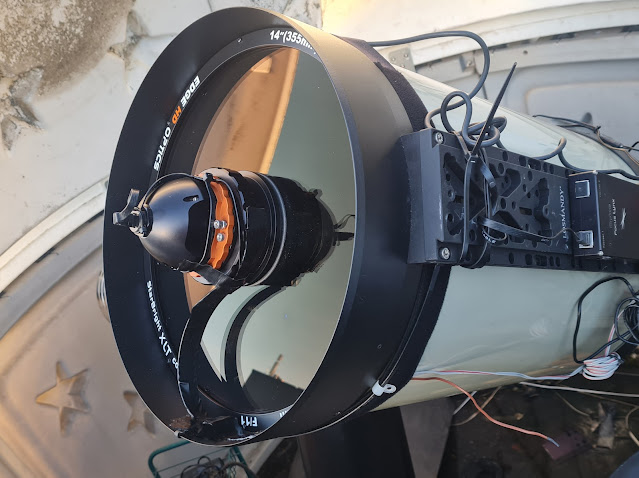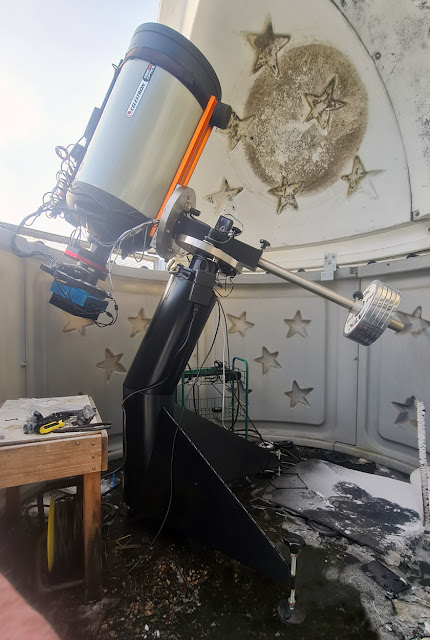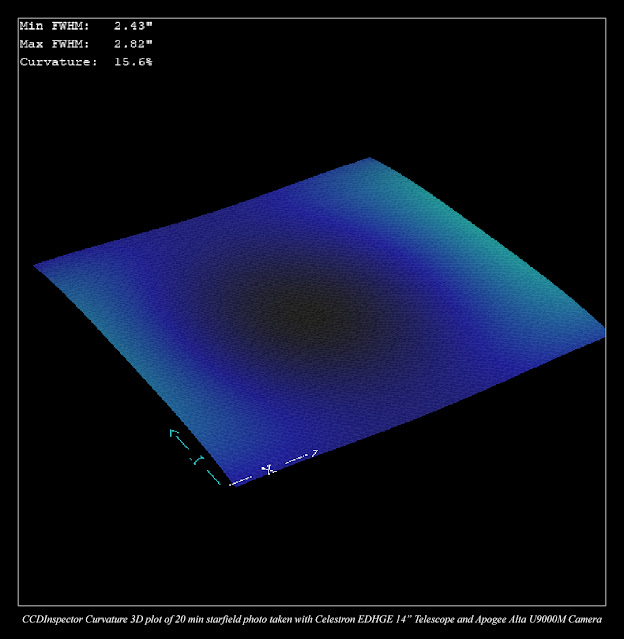COPYRIGHT, PLEASE NOTE
Saturday, September 28, 2024
NEW SETUP FOR MY ASTRONOMICAL NATURE IMAGING WORK
I haven't publish much new images in past two three years since I have had some health problems. Now I'm good as new and can start working again. Past two years I have been slowly building a new imaging platform. I have done some shorter focal length work past six years, now it's time to go closer again.
OPTICS
System is build around Celestron EDGE 14" telescope, I selected this scope due to its light gathering capacity, 356mm diameter and 3910mm native focal length (This very large and heavy 0.7 Reducer is especially made for the EDGE 14") One main difference to normal Celestron EDGE telescope is that I have added a secondary mirror focuser (by Optec) to get rid of a mirror flop. It can be a problem, especially with a heavy mirror. Bottom line, this scope has an excellent optical quality. There is some optical analysis and a single full scale 20min frame at end of this post.
In future I can add a "HyperStar system" to replace secondary mirror and use this telescope as a fast f2 astrograph.
The focuser is made all aluminium, it's really robust and easy to collimate.
I ended up to a MESU Mount MARK II since it has 100kg capacity at imaging work with a periodic error less than 4 arcseconds peak-to-peak, impressive numbers indeed. It also has zero lash back due to its friction drive system. One of the nice features is the 80mm diameter channel for all of the cords, trough the Ra and Dec axes, no more dragging cords!
The pillar I ordered with the mount is bended knee pillar type, no meridian flip is needed and telescope can track whole sky without stopping. The pillar came in easy to handle parts and assembly was very straight forward, the assembled pillar is very rigid under the weight of heavy telescope, counter weights and accessories.
Mesu mount is absolute beautiful engineering work. Support from manufacture is also very good. I had some minor problems with settings at first but they get solved in no time after we went it trough with remote connection, while on site. Bottom line, money wise this mount is a real bargain, if compared its features to any other brand or model of mount.
I have had really good experiences doing long focal length imaging with AO unit during the years. It doesn't correct the actual seeing so much but it corrects every small or big error from heat bubbles and vibrations from heavy traffic, wind, etc. and it does that really really fast.
THE FIRST LIGHT IMAGE
https://astroanarchy.blogspot.com/2024/10/first-light-for-my-new-imaging-setup.html
A single full scale 20 min O-III exposure used for the optical analysis
This is one of the test shots after the collimation procedure. Exposure time is 1200s with 3nm O-III filter. Image is calibrated with Dark Frame and Bias corrected Flat Frame. Target is WR 134 in Cygnus. Stars are pinpoint from corner to corner. There is no stretching done, Click for a full scale image.Tuesday, August 8, 2023
Grand Mosaic of the Milky Way is now large than ever
You can read a blog post about it here: Gigapixel Mosaic of the Milky Way.
This new panorama was published today for the first time in the world by the Finnish Tähdet ja Avaruus magazine.
This is the only photograph in the world that captures the Northern Milky Way with such incredible depth and detail—and now, it’s larger than ever!
Click for a large image, 7000 x 1150 pixels
Over a decade of work, 1500 hours of exposure, and 301 individual frames—all captured in a single image. Note: An image of the Full Moon is included in the lower left corner for scale.
You can now pan and zoom around the large image!
For better accessibility and to save bandwidth, the photo size has been reduced to 40,000 × 6,000 pixels from the original 120,000 × 18,000 pixels.
Note: All material on this blog is copyrighted. Any use without the author's permission is strictly prohibited.
- Panorama spans 145 x 22 degrees of sky (Full Moon covers 0,5 degrees of sky)
- Resolution 120.000 x 18.000 pixels
- Photos has 2.2 gigapixels in it, the spatial resolution is equal to 8.8 gigapixel image from color camera since all the channels are in native resolution.
- There are least nine confirmed supernova remnants in this panorama
- About 25 million stars are visible in the photo
- Distance to the nebulae in the image between 350 to 20.000 light years
- Exposure time over 1500 hours between 2009 - 2021
- 301 individual images are stitched together seamlessly
- It took about 12 years to finalize this photo
- Narrowband image from light of ionized elements, hydrogen = green, sulfur = red and oxygen = blue
- Processing time for the whole panorama, way too large part of my life
Click for a large image
I had to develop many new working methods to successfully manage this massive project. These methods had to be perfected before starting, because once the project was underway, any major changes would have required canceling it entirely.
Every detail had to be precisely planned—from the composition and its alignment with Milky Way structures to numerous technical aspects, such as handling data from different optical systems with varying spatial resolutions.
I won’t go too deep into the technical details, as the complex techniques involved are simply tools—a means to create my art.
I like to compare my long imaging projects to a relationship. But in this case, it wasn’t just between two entities—it was like being in a relationship with an entire family, a large and complex clan. Just like in a family, there might be a difficult uncle or some other challenging personalities, but you have to learn to work with them. I felt the same way while stitching together the pieces of this mosaic. Some frames simply didn’t fit the way I wanted, forcing me to reshoot them, which often took months or even years. But in the end, everything came together seamlessly, without any visible gaps.
I am a perfectionist when it comes to my photography. While this trait is essential for achieving great results, it can also be a challenge. This photo could have been finished five years earlier if I had been willing to leave out some of the extremely faint targets or settle for less detail—but I simply couldn’t.
Yet, when the image was finally complete, I didn’t think about all those sleepless, freezing nights. Instead, I remembered the pure joy I felt when the most challenging parts finally came together.
NOTE, all material in this blog is under copyright, any kind of usage without authors permission is forbidden.
Step 3,
2019 -2021, SOLVING THE BIG PUZZLE
Finally, in 2019, after so many years of work, I had gathered enough material to begin assembling the final mosaic image. The process took nearly two years due to the complex structure of the mosaic and the sheer volume of image data.
At the same time, I also had to capture additional missing material to complete the mosaic, making the process even more time-consuming. But every piece was essential to ensure the final image was as detailed and seamless as possible
I used the Cartes du Ciel, a star map software, for planning and a
preliminary fit the individual frames.
Click for a large image
AND FINALLY
At October 2021, after 12 years, 1500 hours of exposures and countless hours of work
The Grand Mosaic of the Milky Way Galaxy II
NOTE, all material in this blog is under copyright, any kind of usage without authors permission is forbidden.
I was certain I had captured that particular section three years ago, yet no matter how hard I searched, I couldn’t find it on any of my hard drives. As a result, I had to endure several painfully long weeks waiting for the right conditions to reshoot the missing piece. Only then could I finally complete this massive cosmic puzzle.
Optical Configurations
Over the years, I have used several optical setups to capture this mosaic.
- Up until 2014, I worked with a Meade LX200 GPS 12" telescope, a QHY9 astro camera, Canon EF 200mm f/1.8 optics, and a Baader narrowband filter set.
- Since 2014, I have used a 10Micron 1000 equatorial mount, an Apogee Alta U16 astro camera, a Tokina AT-X 200mm f/2.8 lens, and an Astrodon 50mm square narrowband filter set.
I have also captured many high-resolution details using longer focal lengths:
- Before 2014: Meade 12" telescope with a reducer
- After 2014: Celestron EDGE 11" with a reducer
- Guide cameras: Lodestar and later Lodestar II
I chose my current setup as the base tool for this project because it offers a high resolution combined with an exceptionally large field of view. Additionally, it collects photons very efficiently due to being undersampled, allowing extremely faint background nebulosity to become visible in a relatively short exposure time—often, a 30-minute frame is sufficient.
Mosaic Processing
I assemble all my mosaic images in Photoshop. Aligning the individual panels using stars as reference points is fairly straightforward. Over the years, my processing workflow has become so consistent that only minor adjustments—such as small tweaks to levels, curves, and color balance—are needed between frames.
To enhance details, I have incorporated many high-resolution subframes into the mosaic (see the mosaic map at the top of the page). To seamlessly integrate longer focal length images with shorter focal length data, I developed a custom method:
- Upscale the short focal length frames by ~25% to provide more room for high-resolution data.
- Match the high-resolution image to the mosaic, using stars as reference points.
- Remove all tiny stars from the high-resolution image to prevent optical distortions.
- Separate the stars from the low-resolution image and blend the starless high-resolution data with the starless low-resolution frame.
- Reintroduce the removed low-resolution stars on top of everything—ensuring zero data loss and maintaining a uniform star field across the entire mosaic.
This method eliminates optical distortions, which are especially noticeable in dense star fields. Since all stars in the final image originate from the same optical setup, I avoid inconsistencies. I use the same star removal technique as in my Tone Mapping Workflow to achieve this seamless integration.
Wednesday, December 21, 2022
Milky Way, 12 years, 1250 hours of exposures and 125 x 22 degrees of sky
https://astroanarchy.zenfolio.com/
It took nearly twelve years to collect enough data for this high resolution gigapixel class mosaic image of the Milky Way. Total exposure time used is around 1250 hours between 2009 and 2021.
" I can hear music in this composition, from the high sounds of sparcs and bubbles at left all the way to a deep and massive sounds at right."
The final photo is about 100 000 pixels wide, it has 234 individual mosaic panels stitched together and 1,7 gigapixels. (Click for a large image) All the frames used are marked in this image. Since many of sub-images and mosaics are independent artworks it leads to a very complex mosaic structure.
NEW, A HD-video from Germany shows my photo in full glory
https://www.youtube.com/watch?v=D-Z60eZ4yqM
(Video in Germany but images are the international language)
Close ups form the parts of the Grande Mosaic
The California Nebula, NGC 1499, can be seen at bottom left of the large mosaic image.
There are about 20 million individual stars visible in the whole mosaic image.
Click for a large image
Image spans 125 x 22 degrees of the Milky About 20 million individual stars are visible in my photo!
My processing workflow is very constant so very little tweaking was needed between the mosaic frames. Total exposure time is over 1250 hours. Some of the frames has more exposure time, than others. There are some extremely dim objects clearly visible in this composition, like a extremely dim supernova remnant W63, the Cygnus Shell. It lays about six degrees up from North America nebula and it can be seen as a pale blue ring. I spent about 100 hours for this SNR alone. An other large and faint supernova remnant in Cygnus can be seen at near right edge of the image. G65.5+5.7 is as large as more famous Veil nebula. There are over 60 exposure hours for this SNR alone. (Veil SNR is just outside of the mosaic area for compositional reasons but can be seen in "Detail" image above.)
I took my current toolset as a base tool since it has a relatively high resolution combined to a very large field of view. Also it collects photons very quickly since it's undersampled and I can have very dim background nebulosity visible in very short time (many times 30 min frame is enough)
I do all my mosaic work under the PhotoShop, Matching the separate panels by using stars as an indicator is kind of straight forward work. My processing has become so constant, that very little tweaking is needed between separate frames, just some minor levels, curves and color balance.
I have used lots of longer focal length sub-frames in my mosaic to boost details. (See the mosaic map at top of the page) To match them with shorter focal length shots I developed a new method.
Firstly I upscale the short focal length frames about 25% to have more room for high resolution images.Then I match the high res photo to a mosaic by using the stars as an indicator. After that I remove all the tiny stars from the high res image. Next I separate stars from low res photo and merge the starless high res data to a starless low res frame. And finally I place the removed low res stars back at top of everything with zero data lost. Usually there are some optical distortions and it's seen especially in a star field. Now all my stars are coming from a same optical setup and I don't have any problems with distortions. (I'm using the same star removal technique as in my Tone Mapping Workflow)
Click for a large image
Click for a large image,
IC 405 6 410 area
The blog post with technical details can be seen here, https://astroanarchy.blogspot.com/2020/10/the-tulip-nebula-in-cygnus-sh2-101.html



.jpg)

.jpg)
.jpg)

















































